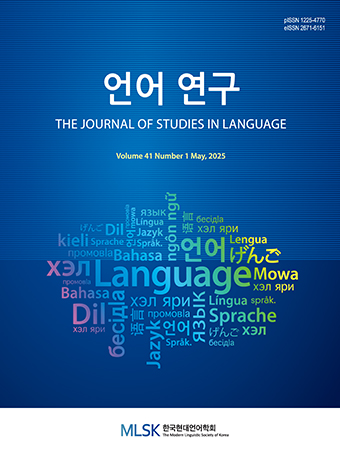Research Article
Abstract
References
Information
Comparative Properties of Zero Anaphora between Tagalog and Korean. This paper comparatively examines the distribution and interpretation of the zero anaphora in Tagalog and Korean in terms of typological perspective. This fact is achieved by drawing a comprehensive account. The two restrictions, speech acts participant (SAP)s and topicality in both languages, are touched upon with the corresponding examples. For SAPs in the interrogative, imperative, exhortative, (and promissive) mood, the overt pronouns’ reference can be categorized within the discourse deixis rather than within the discourse anaphora. In those constructions, the overt pronouns in Tagalog are considered. The overt discourse deixis, the overt pronouns, and optional zero anaphors in Korean are also considered the discourse overt or zero deixis. Another example discussed in terms of topicality in two languages is the discourse anaphoric or zero expression. For topicality, the topical reference is favored by the overt pronoun, while the non-topical one is preferred by the zero anaphora in Tagalog. In contrast, the zero anaphora takes preference over the overt pronoun in referring to the topical referent, while the zero anaphora and the overt pronoun are optional. However the overt pronoun is more preferred in referring to the non-topical referent in Korean.
- Ariel, M. 1990. Accessing Noun Phrase Antecedents. London: Routledge.
- Ariel, M. 1994. Interpreting Anaphoric Expressions: A Cognitive Approach versus a Pragmatic Approach. Journal of Linguistics 30, 3-42. 10.1017/S0022226700016170
- Chomsky, N. 1981. Lectures on Government and Binding. Foris Publications: Dordrecht.
- Fillmore, C. J. 1971. Towards a Theory of Deixis. The PCCLLU Papers 3, 219-241.
- Givón, T. 1983. Topic Continuity in Discourse: An Introduction, In T. Givón (ed.), Topic Continuity in Discourse: A Quantitative Cross-language Study. Amsterdam: John Benjamins, 1-42. 10.1075/tsl.3.01giv
- Gundel, J. K. 1998. Universals of Topic-comment Structure, In Hammond et al. (eds.), Studies in Syntactic Typology. Amsterdam: John Benjamins, 209-239. 10.1075/tsl.17.16gun
- Gundel, J. K., N. Hedberg, and R. Zacharski. 1993. Cognitive Status and the Form of Referring Expressions in Discourse. Language 69, 274-307. 10.2307/416535
- Han, N. 2006. Korean Zero Pronouns: Analysis and Resolution. Ph.D. dissertation, University of Pennsylvania.
- Himmelmann, N. P. 1999. The Lack of Zero Anaphora and Incipient Person Marking in Tagalog. Oceanic Linguistics 38.2, 231-269. 10.1353/ol.1999.0010
- Huang, Y. 1991. A Neo-Gricean Pragmatic Theory of Anaphora, Journal of Linguistics 27.2, 301-335. 10.1017/S0022226700012706
- Kameyama, M. 1985. Zero Anaphora: The Case of Japanese. Ph.D. dissertation, Stanford University.
- Kim, S. 1993. Division of Labor between Grammar and Pragmatics: The Distribution and Interpretation of Anaphora. Ph.D. dissertation, Yale University. 10.17161/KWPL.1808.641
- Lambrecht, K. 1994. Information Structure and Sentence Form: Topic, Focus, and the Mental Representations of Discourse Referents. Cambridge: Cambridge University Press. 10.1017/CBO9780511620607
- Levinson, S. 1983. Pragmatics. Cambridge: Cambridge University Press.
- Levinson, S. 1987. Pragmatics and the Grammar of Anaphora: A Partial Pragmatic Reduction of Binding and Control Phenomena. Journal of Linguistics 23.2, 379-434. 10.1017/S0022226700011324
- Levinson, S. 1991. Pragmatic Reduction of the Binding Conditions Revisited. Journal of Linguistics 27.1, 107-161. 10.1017/S0022226700012433
- Levinson, Stephen C. 2000. Presumptive Meanings: The Theory of Generalized Conversational Implicature. Cambridge, MA: MIT Press. 10.7551/mitpress/5526.001.0001
- Nagaya, N. 2006a. Preferred Referential Expressions in Tagalog. Tokyo University Linguistic Papers 25, 83-106.
- Nagaya, N. 2006b. Topicality and Reference-tracking in Tagalog. 9th Philippine Linguistics Congress, 25-27.
- Nagaya, N. 2007. Information Structure and Constituent Order in Tagalog. Language and Linguistics 8.1, 343-372.
- Naylor, P. 1975. Topic, Focus, and Emphasis in the Tagalog Verbal Clause. Oceanic Linguistics 14.1, 12-79. 10.2307/3622792
- Oh, C. 2007. Topic and Focus Construction in Spoken Korean. Ph.D. dissertation, University of Texas at Austin.
- Yi, H. 2006. Exploring the Formal Representation of Discourse Units with Korean Noun Anaphors and Null Pronouns. Ph.D. dissertation, University of Delaware.
- Publisher :The Modern Linguistic Society of Korea
- Publisher(Ko) :한국현대언어학회
- Journal Title :The Journal of Studies in Language
- Journal Title(Ko) :언어연구
- Volume : 36
- No :3
- Pages :417-432
- DOI :https://doi.org/10.18627/jslg.36.3.202011.417




 The Journal of Studies in Language
The Journal of Studies in Language






